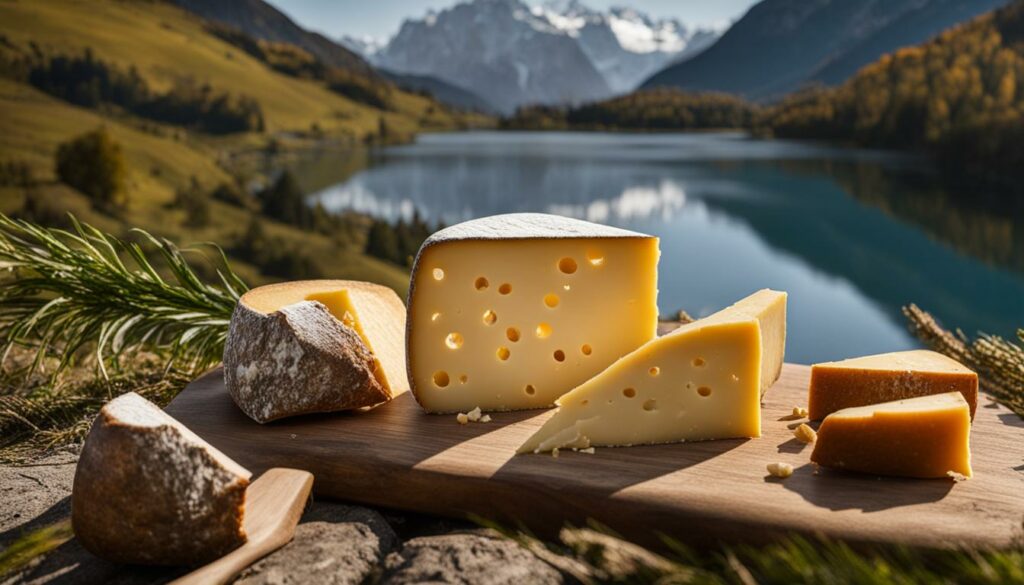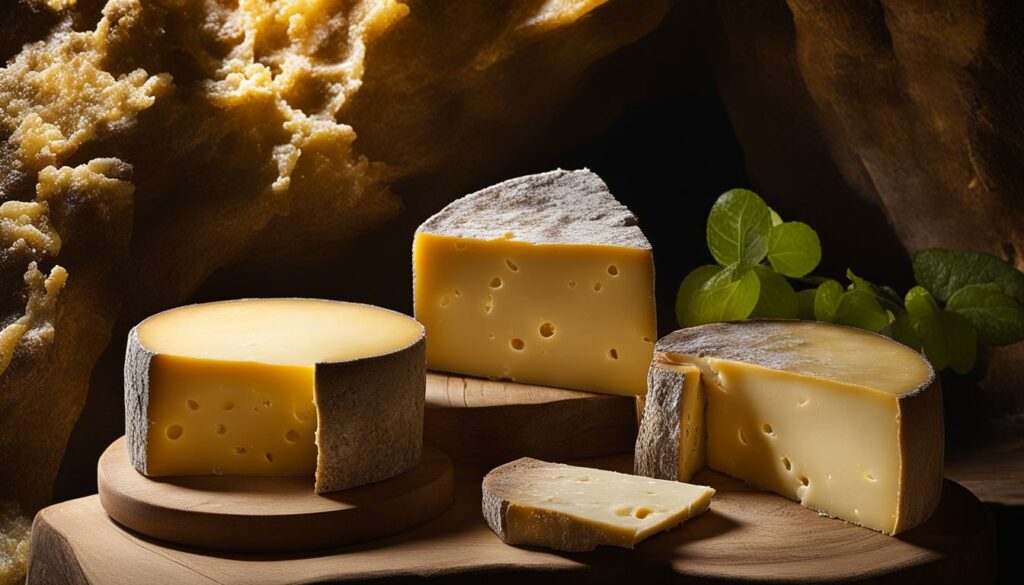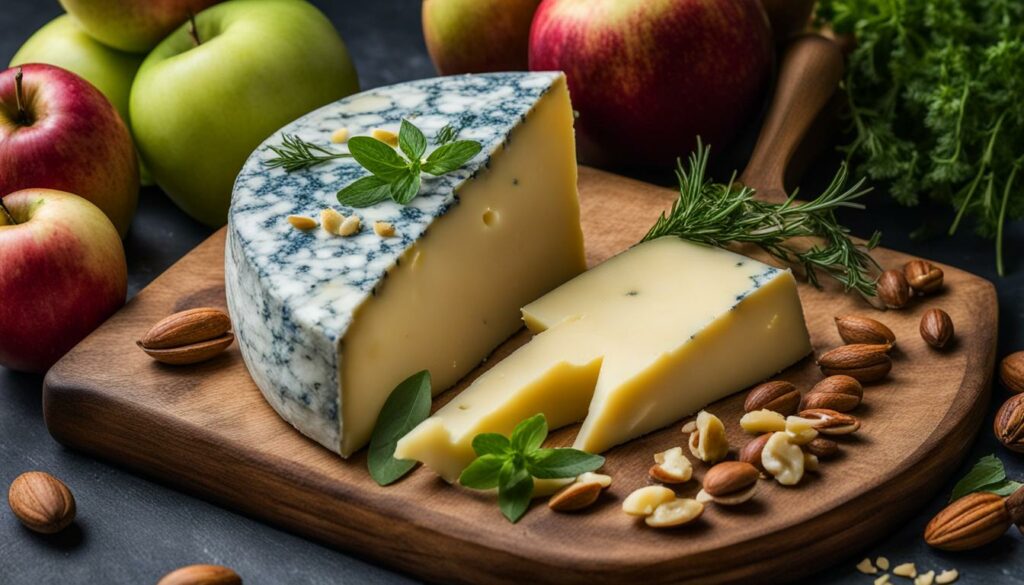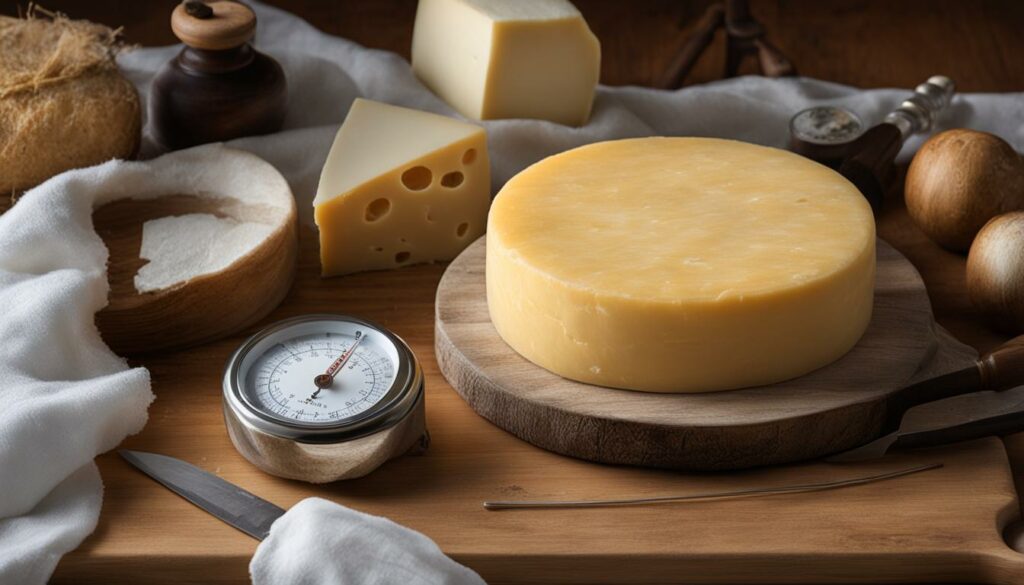Welcome to the world of Castelmagno Cheese, a traditional Alpine cheese that embodies the rich flavors of Piedmont cuisine. This Italian cheese is a true gastronomic treasure, known for its exceptional quality and unique characteristics.
Castelmagno Cheese is an aged, blue cheese with a Protected Designation of Origin (PDO) certification. Made from milk sourced from traditional cattle breeds, it undergoes a meticulous production process that includes coagulation, pressing, and aging in natural caves. The result is a cheese with a distinct flavor profile and a crumbly texture that melts in your mouth.
Whether you’re a connoisseur or a cheese lover looking to expand your palate, Castelmagno Cheese offers a gourmet experience unlike any other. Its artisanal craftsmanship and rich heritage make it a true delicacy, while its versatility in the kitchen makes it a favorite ingredient among chefs.
Join us on a journey to discover the origins, heritage, and culinary possibilities of Castelmagno Cheese. From the breathtaking Alpine pastures where it is produced to the traditional dishes it enhances, you’ll find yourself immersed in the flavors of Italy’s hidden gem.
The Rich Heritage of Castelmagno Cheese
Castelmagno cheese is deeply connected to its land. The alpine pastures where the cheese is produced are located more than 1,700m above sea level, resulting in the delicious milk and extraordinary cheese. The cheese is made between October and May, with young cheeses having a milk-like flavor and aged cheeses developing vegetal notes. Castelmagno cheese from the alpine pastures is a Slow Food Presidium, known for its unique and aromatic flavor.

The journey of Castelmagno cheese begins in the breathtaking alpine pastures, where pristine nature and high altitude create the perfect environment for the production of this exquisite Italian cheese. These mountainous landscapes, nestled above the clouds, provide ideal grazing conditions for the cattle, resulting in milk of exceptional quality and flavor.
Castelmagno cheese is crafted using traditional methods passed down through generations. The cheesemakers carefully transform the milk into curds, which are then molded and aged for at least 60 days in natural caves. This unique aging process is crucial to the development of Castelmagno cheese’s distinctive flavor profile and rich, crumbly texture.
“Castelmagno cheese is a true alpine treasure, originating from the picturesque Italian region of Piedmont. Its unique flavor profile, shaped by the altitude and traditional production methods, makes it a sought-after delicacy for cheese connoisseurs worldwide.”
The Flavor Journey: Aged and Young Castelmagno Cheese
Castelmagno cheese offers a diverse tasting experience, with its flavor evolving as it ages. Young Castelmagno cheeses have a delicate and milky flavor, reminiscent of fresh mountain air and the lush pastures where the cows graze. As the cheese ages, it develops a complex and pronounced taste, characterized by vegetal notes and hints of earthiness.
The Slow Food Presidium
The alpine pastures of Castelmagno cheese are not only the source of its unique flavor but also part of a remarkable culinary heritage. Castelmagno cheese, produced in these breathtaking high-altitude regions, is recognized as a Slow Food Presidium. This prestigious designation is bestowed upon traditional food products that are deeply rooted in their cultural and historical context, and that are produced sustainably, respecting both nature and tradition.
| Cheese Age | Flavor Profile |
|---|---|
| Young Castelmagno Cheese | Milk-like flavor with a hint of mountain freshness |
| Aged Castelmagno Cheese | Complex and pronounced with vegetal and earthy notes |
The Journey of Castelmagno Cheese
Castelmagno cheese has a long and storied history, dating back to the 13th century. This iconic Italian cheese has enjoyed periods of popularity throughout the years, but it faced a significant decline until the 1980s.
“Castelmagno cheese has persevered through the centuries, thanks to the dedication of individuals like Gianni de Matteis. His efforts in promoting and preserving this traditional cheese led to its recognition as a controlled designation of origin (DOP) cheese in 1982 and a protected designation of origin (PDO) cheese in 1996.”
One of the key factors that sets Castelmagno cheese apart is its aging process. After being carefully crafted following traditional production methods, the cheese is aged for a minimum of 60 days. But where does this aging take place? It happens in the ancient Roman turf caves, tucked away in the picturesque region of Piedmont.
Castelmagno Cheese Aging Process in Caves

The aging process of Castelmagno cheese takes place in these natural caves, which contribute to its unique characteristics. The cool, damp environment inside the caves allows the cheese to develop its complex flavors and distinctive aroma over time.
During the aging process, the cheese wheels are carefully stored and monitored, creating the perfect conditions for the desired microbial activity. This prolonged maturation period adds depth and intensity to the cheese, enhancing its flavor and texture.
| Aging Time | Taste | Texture |
|---|---|---|
| 60-90 days | Sharp and tangy | Firm and crumbly |
| 90-120 days | Rich and complex | Firm and slightly creamy |
| 120+ days | Intensely flavored | Hard and crumbly |
The result is a cheese with a distinct and unparalleled taste, making Castelmagno cheese a true gastronomic treasure.
Castelmagno Cheese in the Kitchen
Castelmagno cheese is a versatile ingredient that can elevate your dishes to new heights. Whether you’re looking to add a burst of flavor or a creamy texture, this Italian cheese is the perfect choice. Its unique characteristics make it an excellent addition to a variety of traditional dishes.
One of the best ways to enjoy the versatility of Castelmagno cheese is by using it to make sauces and fillings for fresh pasta. The cheese melts beautifully, creating a rich and savory sauce that coats the pasta perfectly. Whether you’re whipping up a classic fettuccine Alfredo or a more adventurous gnocchi with Castelmagno cream sauce, your taste buds are in for a treat.
“Castelmagno cheese adds a delightful depth of flavor to any pasta dish. Its tangy notes and creamy texture take the dish to a whole new level.”
If you’re a fan of polenta and mushrooms, you’re in for a treat. Castelmagno cheese pairs exceptionally well with these earthy ingredients. Whether you’re making a cheesy polenta topped with sautéed mushrooms or a creamy mushroom risotto, the combination of flavors is simply divine.
When it comes to Piedmont cuisine, Castelmagno cheese shines in dishes like gnocchi, risotto, and pasta. Its distinct taste and creamy texture add a decadent touch to these traditional recipes. You can even sprinkle grated Castelmagno cheese on top of your favorite pasta dish for an extra burst of flavor.
If you’re ready to explore the culinary possibilities of Castelmagno cheese, here’s a table to help you get creative in the kitchen:
| Traditional Dishes | Recipe Suggestions |
|---|---|
| Fresh Pasta | Castelmagno cheese sauce |
| Polenta | Cheesy polenta with mushrooms |
| Risotto | Mushroom risotto with Castelmagno cheese |
| Gnocchi | Gnocchi with Castelmagno cream sauce |
As you can see, Castelmagno cheese is a versatile ingredient that can bring your dishes to life. Its rich flavor profile and creamy texture make it a favorite among chefs and food enthusiasts alike. Explore the world of Piedmont cuisine with Castelmagno cheese and experience the magic it adds to traditional dishes.

Exploring the Origins of Castelmagno Cheese
Castelmagno cheese traces its roots back to the picturesque Biellese region of Piemonte, Italy. This enchanting area is renowned for its natural beauty, boasting attractions such as the magnificent Serra Hill, which happens to be the longest moraine in Europe. Another gem is Lake Viverone, where visitors can enjoy the tranquil waters and breathtaking landscapes.
In addition to its scenic allure, the Biellese region is home to charming historic villages like Masserano and Lessona. These quaint settlements offer a glimpse into Italy’s rich cultural heritage, with their cobblestone streets, ancient buildings, and traditional way of life.
But the Biellese region not only captures the essence of Italian history and architecture; it is also an agricultural haven, producing a range of exquisite local products. Castelmagno cheese, with its distinct flavor profile and artisanal charm, stands out as one of the area’s finest culinary treasures.
The Biellese region is not only celebrated for its cheese but also for its vibrant wine production. Family-owned estates dot the landscape, cultivating vineyards that produce esteemed wines like Bramaterra and Coste della Sesia. These wines perfectly complement the flavors of Castelmagno cheese, creating an unforgettable gastronomic experience.
A visit to the Biellese region offers much more than just culinary delights. It is an opportunity to immerse yourself in nature, history, and timeless traditions. As you explore the region’s castles, vineyards, and the beautiful Oasi Zegna, you’ll discover the true heart and soul of Castelmagno cheese, a culinary gem rooted in the rich heritage of the Biellese region.

Image: A scenic view of the Biellese region, the birthplace of Castelmagno cheese.
Conclusion
Castelmagno cheese is truly a hidden gem in the world of Italian cheeses. Its rich heritage, traditional production methods, and unique flavor profile make it a gourmet delight that is worth exploring. Whether you savor it on its own, incorporate it into traditional dishes, or pair it with other ingredients, Castelmagno cheese offers a truly indulgent experience for those who appreciate fine cheeses.
With its origins in the Biellese region of Piemonte, Castelmagno cheese embodies the essence of Italian gastronomy. Its history dating back centuries and recognition as a PDO cheese highlight its importance in Italian culinary culture. Its production, aged for at least 60 days in Roman turf caves, adds to its distinct character and provides a truly exceptional taste.
For those embarking on a gourmet exploration, Castelmagno cheese is a must-try. Its versatile nature allows it to shine in a variety of dishes, whether it’s a creamy sauce for pasta, a delicious filling for fresh pasta, or paired with polenta and mushrooms. Castelmagno cheese opens the door to a world of flavors, inviting you to savor the true taste of Italy’s alpine treasure.
FAQ
What is Castelmagno cheese?
Castelmagno cheese is a traditional Italian cheese made from milk sourced from traditional cattle breeds. It is an Alpine cheese that is aged for at least 60 days in natural caves, resulting in its unique flavor profile and texture.
What makes Castelmagno cheese unique?
Castelmagno cheese is deeply connected to its land, with the alpine pastures located more than 1,700m above sea level. The cheese is made between October and May, with young cheeses having a milk-like flavor and aged cheeses developing vegetal notes. It is also a Slow Food Presidium, known for its unique and aromatic flavor.
What is the history of Castelmagno cheese?
Castelmagno cheese has a long history, first mentioned in documents dating back to the 13th century. It experienced popularity in the 19th century but declined until the 1980s. It was then promoted by Gianni de Matteis, leading to its recognition as a controlled designation of origin (DOP) cheese in 1982 and a PDO cheese in 1996.
How is Castelmagno cheese produced?
Castelmagno cheese is made by heating milk sourced from traditional cattle breeds and adding liquid calf rennet to coagulate the curd. The curd is then cut, pressed, and hung to drain off excess whey. The cheese is fermented and aged for at least 60 days in natural caves, enhancing its unique characteristics.
How can Castelmagno cheese be used in the kitchen?
Castelmagno cheese is a versatile ingredient that can be used in various dishes. It is ideal for making sauces and fillings for fresh pasta and pairs exceptionally well with polenta and mushrooms. It can also be used in dishes like gnocchi, risotto, and pasta, adding its unique flavor to Piedmont cuisine.
Where does Castelmagno cheese come from?
Castelmagno cheese originates from the Biellese region of Piemonte, Italy. The area is known for its natural beauty, including Serra Hill, the longest moraine in Europe, and Lake Viverone. Visitors can explore the region’s gastronomic delights while staying in castles and exploring the Oasi Zegna.
Why is Castelmagno cheese considered a hidden gem?
Castelmagno cheese is a hidden gem in the world of Italian cheeses due to its rich heritage, traditional production methods, and unique flavor profile. It offers a truly indulgent experience for those who appreciate fine cheeses.







